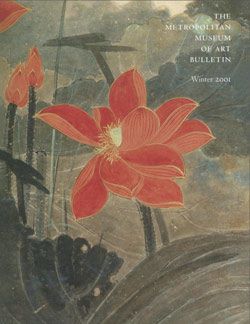Bodhidharma
Qi Baishi Chinese
Not on view
This painting, done when Qi Baishi was visiting Beijing, presents an image of the fifth-century Chan (Zen) patriarch that is accessible yet monumental. The monklike robe, shoe, and stubble of his shaven head are details that give Bodhidharma a contemporary appearance-not unlike Qi himself. But Qi's vision of the master remains beyond our reach. Except for cursory highlighting around the eye and cheek, Qi avoided Western-influenced tech-niques for rendering form and concealed most of the figure beneath the engulfing robe.
Bodhidharma is depicted against a blank background; only the straw prayer mat and the hem of the robe hint at three-dimensional form. Although the bold outlines of the garment and the blunt, square calligraphy of the inscription show close stylistic affinities with the epigraphic school of writing practiced by Zhao Zhiqian (1829–1884), the expressive portrait exhibits the simplicity and directness that characterized Qi's mature style of the 1920s. In his inscription Qi reflects on his inspiration-a visit to Mount Song, where Bodhidharma meditated for nine years-and takes pleasure in acknowledging his own growing critical recognition. He recalls a poem about his painting of a Bodhidharma hung in a Beijing shop that inspired him to repeat his performance here.
This image cannot be enlarged, viewed at full screen, or downloaded.
This artwork is meant to be viewed from right to left. Scroll left to view more.



